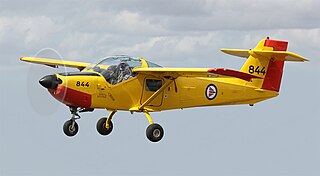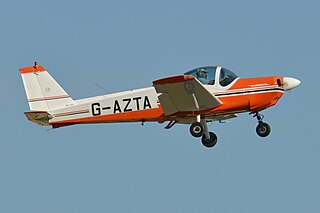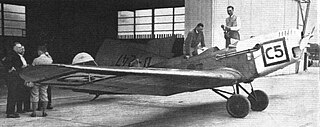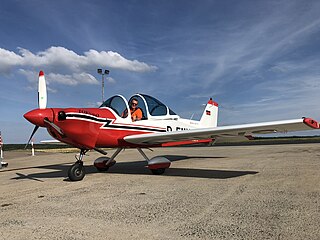The Klemm Leichtflugzeugbau GmbH was a German aircraft manufacturer noteworthy for sports and touring planes of the 1930s.

The Continental C90 and O-200 are a family of air-cooled, horizontally opposed, four-cylinder, direct-drive aircraft engines of 201 in3 displacement, producing between 90 and 100 horsepower.

The North American F-107 is North American Aviation's entry in a United States Air Force tactical fighter-bomber design competition of the 1950s, based on the F-100 Super Sabre. It incorporated many innovations and radical design features, notably the over-fuselage air intakes. The competition was eventually won by the Republic F-105 Thunderchief, and two of the three F-107 prototypes ended their lives as test aircraft. One is on display at the National Museum of the United States Air Force and a second at Pima Air and Space Museum.

Saab MFI-15 Safari, also known as the Saab MFI-17 Supporter, is a propeller-powered basic trainer aircraft used by several air forces.

The Klemm Kl 35 is a German sporting and training aeroplane developed as a successor to the Kl 25. A product of Klemm Leichtflugzeugbau Gmbh it shared the same single-engine, cantilever low-wing configuration as the earlier machine, the major difference being the introduction of an inverted gull wing.

The Bücker Bü 133 Jungmeister is an advanced trainer of the Luftwaffe in the 1930s. It was a single-engine, single-seat biplane of wood and tubular steel construction and covered in fabric.

The Aeronca Model 7 Champion, commonly known as the "Champ", or "Airknocker", is a single-engine light airplane with a high wing, generally configured with fixed conventional landing gear and tandem seating for two occupants.
The Klemm Kl 151 was a German prototype light passenger aircraft designed by Dr. Hanns Klemm and chief engineer Carl Bucher during World War II. Only one model was built.

The Bölkow Bo 207 was a four-seat light aircraft built in West Germany in the early 1960s, a development of the Klemm Kl 107 built during World War II.

The MBB Bo 209 Monsun is a two-seat light aircraft that was developed in West Germany in the late 1960s.

The Oberlerchner JOB 15 was an Austrian two-seat light aircraft produced by Josef Oberlerchner Holzindustrie, which had previously designed and built gliders.

The AVIA FL.3 was an Italian two-seat cabin monoplane designed and built by Azionaria Vercellese Industrie Aeronautiche (AVIA) who were later taken over by Lombardi in 1947.

The Piel CP-30 Emeraude is an aircraft designed in France in the mid-1950s and widely built both by factories and homebuilders.

The PZL-102 Kos (blackbird) is a Polish two-seat touring and training monoplane designed and built by PZL.

The SIPA S.90 was a French-built two-seat light touring and training aircraft of the 1940s and 1950s.

The Beechcraft MQM-107 Streaker is a reusable, turbojet powered, target towing drone primarily used by the United States Army and the United States Air Force for testing and training. The US Army uses the drone for testing various surface-to-air missile systems such as the FIM-92 Stinger and the MIM-104 Patriot. The US Air Force uses them in practice engagements for their air-to-air missiles like the AIM-9 Sidewinder and the AIM-120 AMRAAM.

The Scheibe SF-23 Sperling (en:Sparrow) is a 1950s German two-seat cabin monoplane.

The Dittmar HD 153 Motor-Möwe was a West German light aircraft that was first flown in November 1953.

The Klemm L 26, later Klemm Kl 26, was a low-wing trainer aircraft built by Klemm.

The Mylius My 102 Tornado is a prototype single-seat German aerobatic aircraft. It was designed as a smaller derivative of the MBB Bo 209, but was not placed in production, with only two aircraft built.




















